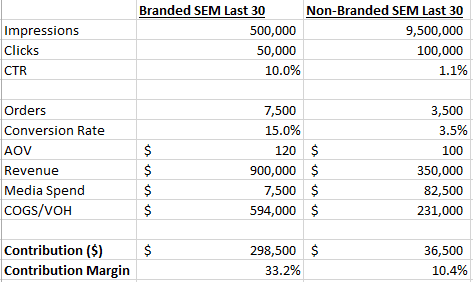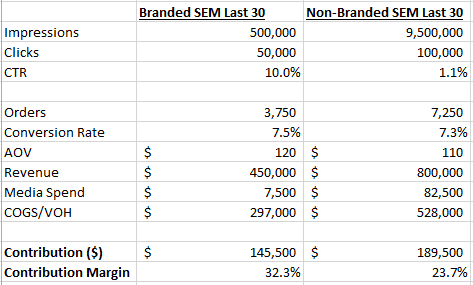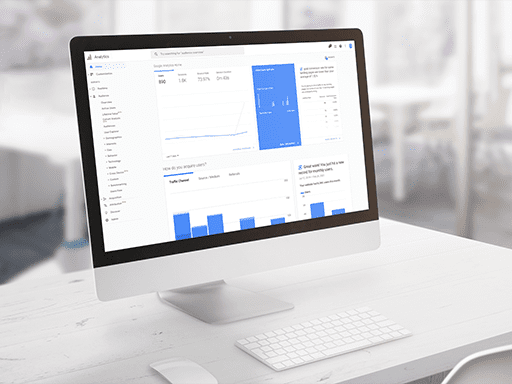Much like direct traffic, branded queries often occur when a searcher learns of your brand through a previous marketing effort, communication, or product search – and this makes optimization of your non-branded channel a bit more complex.
If branded search is truly the result of a previous marketing effort, such as a non-branded search campaign, then it’s important to properly align non-branded marketing expenses with the branded sales which were impacted by that spend.
Luckily, there’s an easy way to improve attribution by re-attributing those sales which were closed by branded that really should be credited to non-branded.

The Status Quo
Google Analytics provides both custom channel groupings and multi-channel funnels reporting, which can be used to re-attribute sales that were credited to branded but were actually impacted by non-branded. However, these methods have two drawbacks:
1) neither functions with the Google Analytics API (at least, not in the way this analysis requires); and
2) these are fairly manual processes which will need to be repeated regularly.
That’s a tall order for any business owner who is also handling all the marketing. There is actually a much easier method for re-attributing these sales which will also function with the Google Analytics API, and thus, can become a fully automated component of your regular account analysis; the utm_nooverride=1 parameter.

How The Parameter Works
Essentially the utm_nooverride=1 parameter tells Google Analytics not to overwrite the existing referral data for a visitor.
For example, imagine a visitor previously came to the website via a non-branded search ad, then returns via a branded search ad. Rather than attributing the new session to the branded ad, the utm_nooverride=1 parameter tells Google Analytics to instead attribute this session to the previous one. In this case the non-branded search ad.
If this user converts during this session, the conversion will be attributed to the non-branded search ad – the previous source.

Implementation
There are two steps to implementation. First, append the ‘?utm_nooverride=1’ parameter to the final ad URL on all branded ads. Do not append the tag to all ads – only branded URLs. Your URLs should appear as domain.com/?utm_nooverride=1.
Next, enable the manual tagging override setting in Google Analytics (if you are using Google Ads use auto-tagging).

That’s it. While this change is not retroactive, you should now see the split of branded to non-branded sales begin to change. After a few days, you can use the multi-channel funnels reports to confirm that the change has worked, if you don’t see an immediate noticeable impact on your search attribution.
Factors to Consider Before Implementing
This change will not only re-attribute branded sales to non-branded search, but will also re-attribute them to email, social, referral, etc. if there is any previous referral data associated with those visitors. If there is significant overlap between branded search and other channels, then you may see the total sales attributed to your SEM channel decline, so be prepared for this change to impact your forecasts.
PRO TIP: Be sure to format the tag properly. The tag contains an ‘=1’ parameter – this value should always remain as ‘1’. Do not setup your tags as ‘utm_nooverride=2/3/4/etc.’ as the parameter will simply not function.
The Impact of Correct Search Attribution
How much difference can one small change make? Let’s explore the following scenario.
Here’s the branded and non-branded search marketing KPIs for Husky’s Furniture Co, a fictional retailer selling furniture through their e-commerce and catalog channels. Due in part to the massive success of their catalog, Husky’s branded search channel is exceptionally large.

Husky’s executive management team wants to maximize non-branded profits so long as average margin doesn’t drop below 10% – meaning they want to pocket at least 10% of sales as profit but are willing to re-invest the remainder. Priority is given to maximizing profit dollars so long as the average margin at which profit is maximized does not drop below 10%.
In the table above you can see that according to the default Google Analytics search attribution model, branded accounts for 72% of revenue (pre-catalog matchbacks) during the past 30 days. However, non-branded is where the bulk of the investment in paid search is currently going, yielding $350k in sales on $82.5k in media spend. After cost of goods/variable overhead, the retailer walks away with 10.4%, or $36,500 in contribution. There’s little room here to generate incremental sales through further investment without falling below the 10% margin threshold.
Now, let’s re-attribute those sales which were closed by branded but previously impacted by non-branded, using the ‘utm_nooverride’ parameter.

Husky’s branded/non-branded overlap was equivalent to 50% of orders and 50% of revenue. After re-attributing those sales to non-branded, the picture completely changes. Non-branded gains $450k in sales, lifting contribution margin to 23.7%. In this example, none of the remaining branded sales were impacted by other web channels (though that may not be the case with your data.)
Given leadership’s decision to maximize non-branded profit with a minimum 10% margin, this retailer now has significant room to invest further in the channel, which will grow new sales and acquire more new customers. They’ve accelerated the current and future growth of the business – with one attribution change.

Hypothetically, Husky’s has in the ballpark of $109,500 in contribution which can be re-invested into the channel, assuming impression share isn’t maxed out ($82k in media spend + $109.5k in available invest = $192k total media spend. At $800k in revenue, that will yield a 10% margin.)
What if Husky invests those dollars into the non-branded channel, and ad to sales ratio (A/S) jumps from 10% to 24%? Even given the diminishing returns, they’ll still drive an incremental $450k in revenue at a margin of 10%. Calculating the incremental investment on the figures above, Husky’s can expect to increase non-branded revenue to $1.25MM, driving an incremental $43,500 in non-branded contribution for the business.

Summary
We often find that improving the quality of account measurement allows for the most significant financial improvements for our clients. While the utm_nooverride=1 parameter is not the only option for adjusting your search attribution model in this manner, it is currently the only one which works with the Google Analytics API.
This eliminates the need for ad hoc analysis and allows you to see this data re-attributed down to the campaign, ad group or keyword level. If you do intend to implement this, I recommend having a discussion about the implications with your executive team first, as it can potentially change the dynamic of your paid search channel quite radically, rendering current budgets and forecasts obsolete.
Still not sure how to implement this parameter, or what effect of changing your branded and non-branded search attribution will have on your business? We’re happy to help – contact us!






